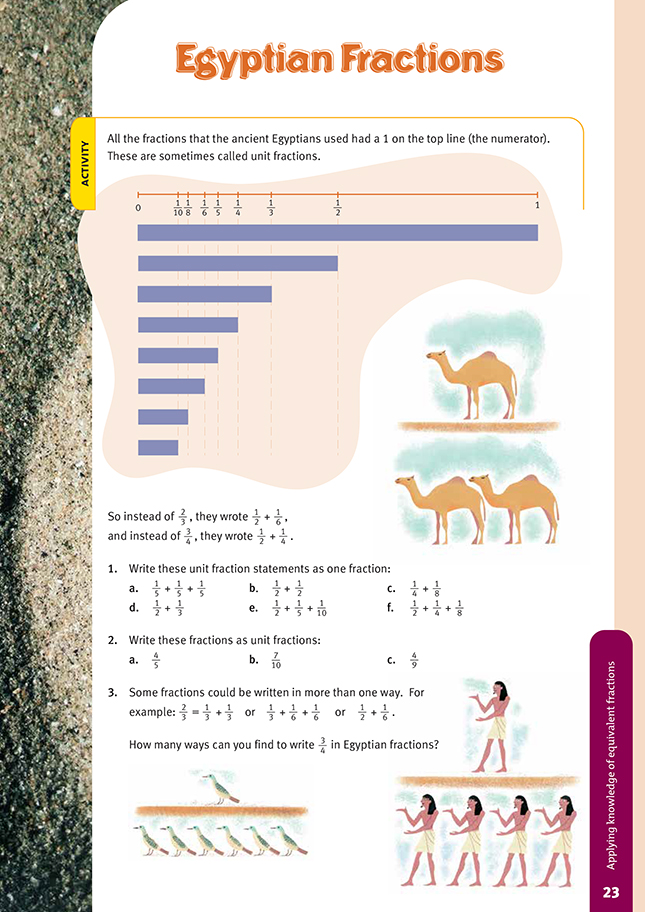This is a level 4 number link activity from the Figure It Out series. It relates to Stage 7 of the Number Framework.
A PDF of the student activity is included.
Click on the image to enlarge it. Click again to close. Download PDF (227 KB)
add related fractions
FIO, Link, Number, Book Five, Egyptian Fractions, page 23
To tackle the first problem in this activity, the students need to convert most of the fractions into fractions with the same denominator (see the notes for page 22 of the students’ book). You may need to discuss with them how to find the lowest common denominator. They will need to convert the 1/2 and 1/4 in question 1c into the equivalent number of eighths, and in question 1d, they will need to convert the 1/2 and 1/3 into the equivalent number of sixths.
Again, the mathematical principle involved is the identity principle. For example 1/2 =/6 can be worked out as 1/2 x (3/3) = 3/6, and 1/3 = /6 can be multiplied by 1 in the form of 2/2 like this: 1/3 x (2/2) = 2/6. Since 3/6 is equivalent to 1/2 and 2/6 is equivalent to 1/3, 1/2 + 1/3 is the same as 3/6 + 2/6, which is 5/6.
You may find that some of your students are still confused about the difference between multiplying and adding fractions. When they are multiplying fractions, they must multiply the numerators and the denominators, but when they are adding fractions, they add only the numerators. Spend time with any students who are
not certain about what to do to ensure that they understand the processes. They will need to know these for later work in algebra. (The denominator is the fraction’s name, for example, thirds. The numerator is the number of parts of that fraction, for example, the number of thirds, quarters, and so on.)
Questions 2 and 3 provide further opportunities for the students to experience the idea that several solutions are possible for some problems, as opposed to there always being just one right answer. In question 2a, for example, the Egyptians could have written 4/5 as 1/5 + 1/5 + 1/5 + 1/5 , 1/2 + 1/5 + 1/10 , or 1/2 + 1/10 + 1/10 + 1/10 , and so on. Encourage the students to share and discuss their various solutions.
Answers to Activity
1. a. 3/5
b. 2/2 or 1
c. 3/8
d. 5/6
e. 8/10 or 4/5
f. 7/8
2. Solutions will vary. Possible solutions include:
a. 1/2 + 1/5 + 1/10
b. 1/2 + 1/5
c. 1/3 + 1/9
3. Solutions will vary. The possibilities for expressing
3/4 using fractions no smaller than 1/8 are:
1/2 + 1/4
1/2 + 1/8 + 1/8
1/4 + 1/4 + 1/4
1/4 + 1/4 + 1/8 + 1/8
1/4 + 1/8 + 1/8 + 1/8 + 1/8
1/8 + 1/8 + 1/8 + 1/8 + 1/8 + 1/8
1/6 + 1/6 + 1/6 + 1/4
